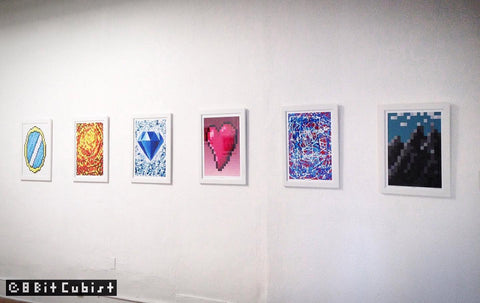Displaying and Storing Your Prints
Posted by Mr Benja on

As you collect prints, you're going to want to display or store them properly. Starting from the most elaborate, you generally have four options: Custom Framing, Simple Framing, DIY Framing, or Using Display Binders.
Each has their benefits, but in the end, they'll all serve you well.
Custom Framing
This is the high-end option and what you will use if the right presentation is important to you. You can look up local art framers in your area (recommendations will help) or opt for the mass-market framers like Michael's or Aaron Brothers. Both types will do a good job presenting your work appropriately. It's up to you on who you're comfortable dealing with.
Without unrolling your artwork, take it to the framer and let them know that you would like it framed. They will ask questions about the look of the frame + mat, and will guide you through their process. You will leave the artwork with them and it will be completed at some agreed upon date.
Although it's the safest for your work and will look the best, this option can get pricey. There can be a long turnaround time from one to three weeks depending on their workload. Look for coupons and deals at different times of the year.
Simple Framing
Simple Framing is a mix between custom framing and the DIY option. You buy a frame from off the shelf, and then a framer uses that frame to place your art.
For example, Michael's Arts & Crafts version of this process is called Frame Express. You will purchase a frame from off the shelf, and then take it to their framing department with your art. This is A LOT less expensive than Custom Framing and will get you great results. They will seal the print and wire it for you as a part of their fee. See their explanation here.
The nice thing about having them do the work is that they're unlikely to screw anything up in the process. It's also much faster. If you don't like Michaels, just contact another framer and see if they can work with off-the-shelf frames or frames that you already have.
DIY Framing
Do it yourself framing is a completely viable option, and one that I started doing when I started collecting prints. It's not that difficult, but it can take a little practice and getting used to. As an artist, I do this more often than most people ever will, but this option can save you a lot of money and turnaround time. You'll also come in handy whenever a friend needs their art displayed.
1. Flattening prints - You might be surprised that art prints come rolled (especially the larger prints). This is a common practice to protect the artwork from bends, creases, and tears. Kraft mailing tubes are also more durable and more convenient than large, rectangular boxes.
To flatten a print, find an open, flat surface that won't be disturbed for a while and clear it of any debris. Carefully unroll the print so that the curl is facing down (as if it's trying to grasp the surface). The tissue paper should be protecting the image. Cover the center and corners with moderately heavy items that won't be easily disturbed (I use books).
Depending on the temperature and humidity where you are, complete flattening could take two or three days. You can also find videos on YouTube.
2. Acquiring frames - While your print is learning how to live outside of a tube, you can go pick up a frame from a frame store or maybe from another painting or work of art. (I wouldn't trust anything from a generic outfit like Target or Wal-Mart, but that's up to you.)
Note: If your frame doesn't have a backing, then things could get tricky. Contact me or an artist/framer you trust before continuing.
3. Wiring the frame - Most off-the-shelf frames usually have some kind of hanging mechanism or hooks for wiring, I usually go for wiring them if the work is any larger than 11x14. You can find hanging kits at Target, Home Depot, Michaels, and other places. They'll include wire, nails, and other goodies. Look online for how to safely wire a frame.
Display Binders / Display Racks
If you have a lot of artwork, you'll find yourself looking for a display binder or display rack. If you ever collected gaming cards or comics, we're about to head in that direction.
Display Binders - These are what you see art students carrying around. They're the big portfolios that they use to showcase all their work. Many people collect their prints in these same types of folders. These are pretty easy to find at art display shops and places like Amazon.
For 12x12 prints or for other sizes, you may find yourself purchasing an archival scrapbooking binder.
Individual Display Covers - If you've ever seen comic books stored properly in boxes, this is what you've seen. They do the same thing for art prints as well. For recommendations, I'd suggest
Display Racks - These are for the true collector. This is necessary when you call your art museum owner over and have to flip through dozens of pieces of artwork while you listen to Mozart or Corelli...or maybe Aphex Twin or Daft Punk in my case. You package your artwork in archival slip covers and backing boards.
For any other options (yes, there are more) or to get specific product recommendations, feel free to contact us or visit an art supply/frame shop. And if there is anything missing in this description, please let us know.
Thanks.
- Mr Benja -
